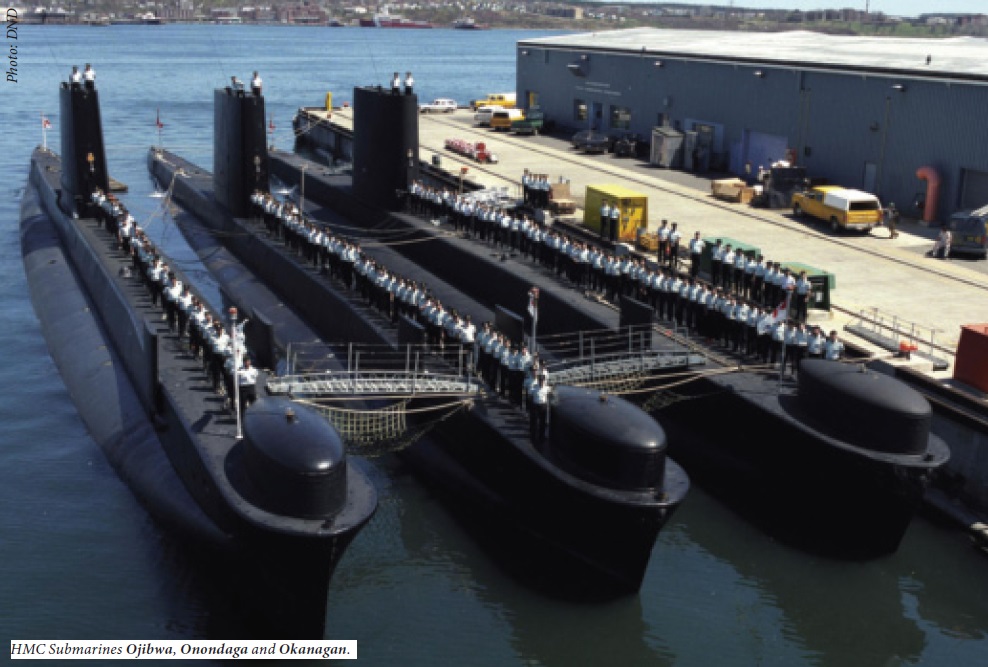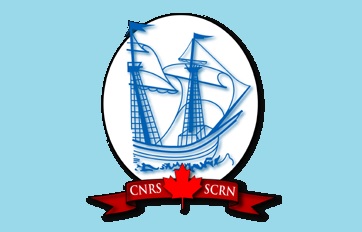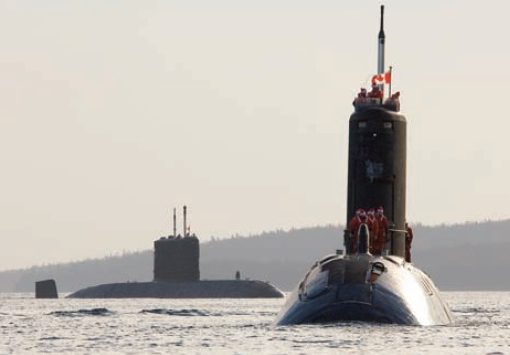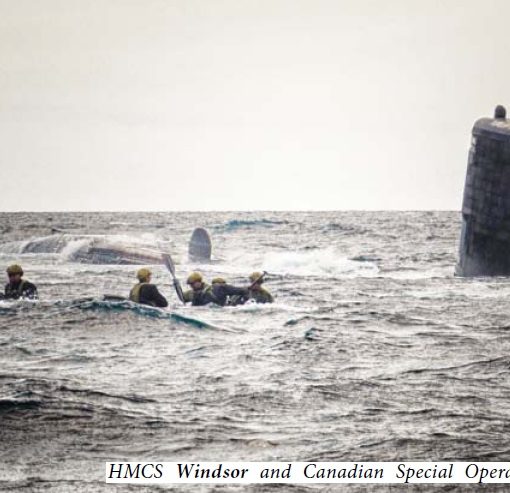Tim Dunne’s article on the Victoria-class submarines entitled "Journalists sub-par on sub debate" challenged journalists to get the facts straight on the Canada’s submarines. It is worthwhile advice for anyone thinking of engaging in this discussion. The current debate identifies the submarines as ‘used’, but little information was offered about the Victoria-class’s former life as the Upholders. During my time on exchange with the Royal Navy in the UK, I worked with the Submarine Naval Architecture Cell in what was then the Sea Technology Group. I had the benefit of rubbing shoulders with some of the Constructors that were involved in the design and build of the class. This my contribution to the story of the Upholders, the UK’s last conventionally powered subs.
The Naval Staff Target (NST), which was the earliest conceptual formulation of the requirement for the class, was developed in the 1970s in recognition that it was time to start thinking about a replacement for the Oberon-class submarine, the RN’s conventional submarine, which would reach end-of-life during the 1980s.
The UK Ministry of Defence (MOD) looked at a range of conventional submarine options from a 500-tonne basic surveillance submarine to a large 2500-tonne ocean-going submarine. The MOD settled on a design displacing around 2250 tonnes as the answer for the Staff Target. Around the same time, Vickers Shipbuilding and Engineering Ltd., UK (VSEL), was developing a comparable conventional submarine design for the export market with a slightly more capable weapons fit, a greater range, and displacing around 2800 tonnes. The MOD and VSEL, after discussions (and no doubt some political manoeuvring) merged their initiatives into a new 2400-tonne design for the NST with enhanced range and weapons. The NST was approved on the basis of this 2400-tonne design, which resulted in the Type 2400 in 1980.
Shortly after approval of the NST and before the detailed design was complete, weight monitoring and development of a 1/5th scale model showed that the full-scale version would experience severe weight and space issues. This led MOD to optimise the design for minimum weight, impose strict weight controls, and eliminate some capability requirements in order to meet the maximum displacement figure. Weight optimisation always comes at the cost of increased engineering complexity, a cost that would later render the design more challenging to understand for Canadian naval engineers.
The Type 2400 was designed for ocean going and coastal patrol missions in temperate and tropical waters. The original operational employment for the Type 2400 included:
- Anti-Submarine operations,
- Anti-Surface vessel operations,
- Surveillance and intelligence gathering,
- Mine laying, and
- Coastal covert operations in support of Special Forces.
The design particulars for the Type 2400 design were:
- Length - 70 meters,
- Maximum pressure hull diameter - 7.6 meters,
- Surface displacement - 2163 tonnes,
- Submerged displacement - 2466 tonnes,
- Max diving depth >200 meters,
- Max speed ~20 knots, and
- Torpedo tubes - 6 (with 12 reload torpedoes)
The maximum submerged displacement without noise cladding was less than 2400 tonnes, which met the NST.
Two areas of design innovation for the RN were incorporated into the class. The first was the “Dutch Breach,” an idea that originated in the Netherlands. It is a large bolted hull section, an area approximately four m2 above the engine room, which allows the removal of diesel-generator sets for maintenance and overhaul. When Canada wanted to change the engines of an Oberon-class submarine, the only solution was to cut the sub in half and then weld it back together.
The second area of innovation was Air Turbine Pumps (ATPs). An ATP is an air-driven pump used to launch torpedoes. This was a change from the RN’s conventional water ram discharge system and offered significant performance advantages: it was more energy efficient, quieter, smaller, and with a longer operational lifecycle.
HMS Upholder (SSK01 and later HMCS Chicoutimi) was laid down by VSEL at their Barrow-in-Furness yard in February 1986. She launched on 2 December, ten months later. The remainder of the class was built at Cammell Laird in Birkenhead. The class was completed during a period of considerable turmoil in the British shipbuilding industry.
The Government of Margaret Thatcher, intent on returning the British Shipbuilders Group to the private sector, sold the Vickers yard at Barrow-in-Furness to an employee-led company, VSEL, in March 1986, which also included its Birkenhead-based subsidiary, Cammell Laird. After the end of the Upholder-class submarine building program in 1993, VSEL announced Cammell Laird’s closure.
The Upholder-class unintentionally ended up on the forefront of this new British shipbuilder relationship, which marked a new approach to procurement in the UK. VSEL owned the intellectual property associated with the design. The UK MOD had rights to use the information, but not to sell it or give it to Canada. This situation would later posed some significant challenges for Canadian engineers seeking basic but proprietary information about our new submarines.
The Weapons Handling and Discharge System (WHDS) suffered from a major design flaw in the control and hydraulic systems; command could not maintain positive control of the bow doors (they could open without an order). The solution, which was called Option Five, caused a three-year delay in the commissioning of HMS Upholder and lesser delays to the second and third boats. The problem was corrected by the time HMS Unicorn was built.
The design and build of the Upholders also represented a step change in technology for the RN. Sixty-seven percent of the hull machinery was new-to-service and for the weapons systems the figure approached 90 percent. VSEL and Cammell Laird also happened to be the only British shipyards capable of producing nuclear submarines. It should come as no surprise that the design of the Type 2400 and the nuclear Trafalgar-class submarines share considerable design similarities. This means that equipment and systems on the Victoria-class are not completely orphans since some systems and equipment share commonality with the RN’s nuclear T-class boats. Nevertheless, the supplier base for the Upholder-class is much smaller than the Oberon-class submarines, which proved another challenge for Canadian engineers. After a short operational life of just 18 months after the design flaws were repaired in HMS Upholder, the British government announced that the RN would operate only a nuclear submarine force and that the Upholders would be withdrawn from service by 1995.
HMS Unicorn was deployed on a long cruise to support the attempt to sell the class. She operated in the Mediterranean and east of Suez, in the Gulf of Oman, the Indian Ocean and the Persian Gulf. In contrast, HMS Ursula was never used operationally.
All four boats were paid off in 1994 and laid up in the water in Barrow-in-Furness with the expectation that the sale of the vessels would follow within six months. The period of time the class was in British hands is shown in the table.
| RN Name | Laid Down | Launched | Commissioned | Paid Off | RCN Name |
| SSK01 Upholder | Feb 86 | Dec 86 | Dec 90 | Apr 94 | SSK 879 Chicoutimi |
| SSK02 Unseen | Aug 87 | Nov 89 | Jul 91 | Apr 94 | SSK 877 Victoria |
| SSK03 Ursula | Feb 87 | Feb 91 | May 92 | Oct 94 | SSK 879 Corner Brook |
| SSK04 Unicorn | Mar 90 | Apr 92 | Jun 93 | Oct 94 | SSK 878 Windsor |
A custody care and maintenance contract at VSEL ensured that the Upholders received planned maintenance support, albeit at a reduced scale. Some items, such as the diesel engines, were placed into deep preservation status and those systems not required to ensure watertight integrity were flushed clean of salt water and then preserved. Had the length of time that it took to sell the boats been fully appreciated, taking the boats out of the water would have been a much better option. It would have eliminated much of the degradation experienced by systems exposed to the corrosive effects of salt water. The uneven degradation of ship systems and equipment later resulted in significant engineering effort to correct issues in Canada.
With four expensive submarines tied up alongside, the UK MOD set about to find a buyer. A government-industry sales team made presentations to eight countries: Canada, Chile, Greece, Pakistan, Portugal, Saudi Arabia, South Africa, and Turkey. The class was eventually sold in 1998, and the now story continues in Canada.





